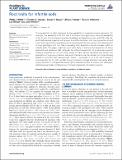Files in this item
Root traits for infertile soils
Item metadata
| dc.contributor.author | White, Philip | |
| dc.contributor.author | George, Timothy | |
| dc.contributor.author | Dupuy, Lionel | |
| dc.contributor.author | Karley, Alison | |
| dc.contributor.author | Valentine, Tracy | |
| dc.contributor.author | Wiesel, Lea | |
| dc.contributor.author | Wishart, Jane | |
| dc.date.accessioned | 2013-06-13T14:01:00Z | |
| dc.date.available | 2013-06-13T14:01:00Z | |
| dc.date.issued | 2013-06-11 | |
| dc.identifier | 55007708 | |
| dc.identifier | cf900f32-9016-44e8-88be-d55fd19f6137 | |
| dc.identifier | 84896397094 | |
| dc.identifier.citation | White , P , George , T , Dupuy , L , Karley , A , Valentine , T , Wiesel , L & Wishart , J 2013 , ' Root traits for infertile soils ' , Frontiers in Plant Science , vol. 4 , 193 , pp. 1-7 . https://doi.org/10.3389/fpls.2013.00193 | en |
| dc.identifier.issn | 1664-462X | |
| dc.identifier.uri | https://hdl.handle.net/10023/3692 | |
| dc.description | This work was supported by the Rural and Environment Science and Analytical Services Division (RESAS) of the Scottish Government through Workpackage 3.3 (2011–2016) | en |
| dc.description.abstract | Crop production is often restricted by the availability of essential mineral elements. For example, the availability of N, P, K, and S limits low-input agriculture, the phytoavailability of Fe, Zn, and Cu limits crop production on alkaline and calcareous soils, and P, Mo, Mg, Ca,and K deficiencies, together with proton, Al and Mn toxicities, limit crop production on acid soils. Since essential mineral elements are acquired by the root system, the development of crop genotypes with root traits increasing their acquisition should increase yields on infertile soils. This paper examines root traits likely to improve the acquisition of these elements and observes that, although the efficient acquisition of a particular element requires a specific set of root traits, suites of traits can be identified that benefit the acquisition of a group of mineral elements. Elements can be divided into three Groups based on common trait requirements. Group 1 comprises N, S, K, B, and P. Group 2 comprises Fe, Zn, Cu, Mn, and Ni. Group 3 contains mineral elements that rarely affect crop production. It is argued that breeding for a limited number of distinct root ideotypes,addressing particular combinations of mineral imbalances, should be pursued. | |
| dc.format.extent | 7 | |
| dc.format.extent | 446498 | |
| dc.language.iso | eng | |
| dc.relation.ispartof | Frontiers in Plant Science | en |
| dc.subject | Root architecture | en |
| dc.subject | Mineral nutrition | en |
| dc.subject | Rhizosphere | en |
| dc.subject | Soil solution | en |
| dc.subject | Uptake | en |
| dc.subject | Q Science | en |
| dc.subject | S Agriculture | en |
| dc.subject | Agricultural and Biological Sciences(all) | en |
| dc.subject.lcc | Q | en |
| dc.subject.lcc | S | en |
| dc.title | Root traits for infertile soils | en |
| dc.type | Journal article | en |
| dc.contributor.institution | University of St Andrews. School of Biology | en |
| dc.contributor.institution | University of St Andrews. St Andrews Sustainability Institute | en |
| dc.identifier.doi | 10.3389/fpls.2013.00193 | |
| dc.description.status | Peer reviewed | en |
This item appears in the following Collection(s)
Items in the St Andrews Research Repository are protected by copyright, with all rights reserved, unless otherwise indicated.

